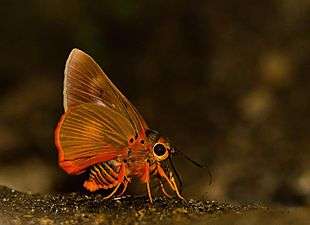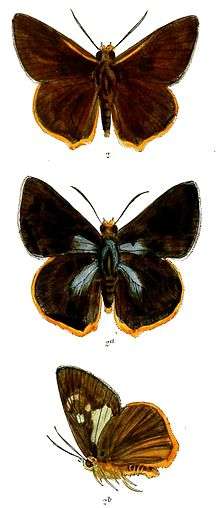Burara jaina
Burara jaina, the orange awlet,[2][3] is a species of hesperid butterfly found in Asia.[4] The butterfly was reassigned to the genus Burara by Vane-Wright and de Jong (2003), and is considered Burara jaina by them.[5][1]
| Orange Awlet | |
|---|---|
 | |
| Scientific classification | |
| Kingdom: | |
| Phylum: | |
| Class: | |
| Order: | |
| Family: | |
| Genus: | |
| Species: | B. jaina |
| Binomial name | |
| Burara jaina | |
| Synonyms | |
| |
Range
The orange awlet is found in India, Myanmar, Thailand and Vietnam.[6][3]
In India, this butterfly is found in the Western Ghats and the Himalayas from Garhwal (Mussoorie) to Sikkim and Assam eastwards to Myanmar.[2][3][7]
The type locality is Darjeeling in West Bengal, India.[3]
Description

Both sexes: The butterfly, which has a wingspan of 60 to 70 mm, is a dark vinaceous (colour of red wine) brown above. The forewing has an orange costal streak from the base above the cell to about halfway along the wing, while the hindwing has an orange fringe. The butterfly is paler below and has orange bands along the veins of the hindwing.[7]
Male: The male may have an indistinct dark brand placed centrally on the forewing above, between mid 1b to vein 3.[7]
Edward Yerbury Watson (1891) gives a detailed description, shown below:[8]
Male. Upperside forewing with an orange red subcostal basal streak and an indistinct blackish patch beneath the cell; front of thorax, anal tuft, and cilia of hindwing bright orange red; thorax and base of abdomen clothed with bluish grey hairs. Underside paler brown; both wings with a small black orange red bordered basal spot: forewing with a well-defined purplish white spot within the cell; and a curved discal series of narrow less defined spots; posterior margin broadly yellow: hindwing with the veins towards the abdominal margin and cilia orange red; a curved ill-defined series of narrow purplish white discal streaks. Third joint of palpi brown; thorax beneath greyish; middle of abdomen beneath and sides of the bands and legs orange red. Female similar, but with darker bluish grey hairs without the orange red subcostal streak and black discal patch.
- Life cycle
.jpg) Larva
Larva.jpg) Chrysalis
Chrysalis.jpg) Imago (dorsal view)
Imago (dorsal view) Imago (lateral view)
Imago (lateral view)
Habits
The orange-striped awl is an insect of the low foothills with dense jungles and heavy rainfall. It is rarely seen out of such terrain. Crepuscular in nature, it flies early in the mornings or late in the evenings. It has strong, fast and straight flight. It is best seen in ravines and nullahs. It hovers at leaves and visits Lantana and other attractive flowers.[1][7]
Host plants
The larva has been recorded on Hiptage benghalensis and Combretum latifolium.[9][3]
Cited references
- Vane-Wright and de Jong (2003) (see TOL web pages on genus Bibasis genus Burara in the Tree of Life Web Project) state that Bibasis contains just three diurnal species, the crepuscular remainder having been removed to Burara. The species now shifted to Burara are morphologically and behaviorally distinct from Bibasis, within which many authors have formerly included them.
- R.K., Varshney; Smetacek, Peter (2015). A Synoptic Catalogue of the Butterflies of India. New Delhi: Butterfly Research Centre, Bhimtal & Indinov Publishing, New Delhi. p. 24. doi:10.13140/RG.2.1.3966.2164. ISBN 978-81-929826-4-9.
- Markku Savela's website on Lepidoptera. Page on genus Bibasis.
-

- Vane-Wright, R. I.; de Jong, R. (2003). "The butterflies of Sulawesi: annotated checklist for a critical island fauna". Zoologische Verhandelingen. 343: 3–267.
- Inayoshi, Yutaka. "Burara jaina jaina (Moore,[1866])". Butterflies in Indo-China.
- Wynter-Blyth, Mark Alexander (1957). Butterflies of the Indian Region. Bombay, India: Bombay Natural History Society. pp. 468–469. ISBN 978-8170192329.
-

- Ravikanthachari Nitin; V.C. Balakrishnan; Paresh V. Churi; S. Kalesh; Satya Prakash; Krushnamegh Kunte (2018-04-10). "Larval host plants of the buterfies of the Western Ghats, India". Journal of Threatened Taxa. 10 (4): 11502. doi:10.11609/jott.3104.10.4.11495-11550 – via JoTT.
See also
References
Print
- Evans, W.H. (1932). The Identification of Indian Butterflies (2nd ed.). Mumbai, India: Bombay Natural History Society.
- Watson, E. Y. (1891) Hesperiidae indicae. Vest and Co. Madras.
- Wynter-Blyth, Mark Alexander (1957). Butterflies of the Indian Region. Bombay, India: Bombay Natural History Society. ISBN 978-8170192329.
Online
- Beccaloni, George; Scoble, Malcolm; Kitching, Ian; Simonsen, Thomas; Robinson, Gaden; Pitkin, Brian; Hine, Adrian; Lyal, Chris. "The Global Lepidoptera Names Index (LepIndex)". Natural History Museum, London. Retrieved 2016-10-15.
- Brower, Andrew V. Z. and Warren, Andrew, (2007). Coeliadinae Evans 1937. Version 21 February 2007 (temporary). http://tolweb.org/Coeliadinae/12150/2007.02.21 in The Tree of Life Web Project, http://tolweb.org/
- "Markku Savela's website on Lepidoptera".